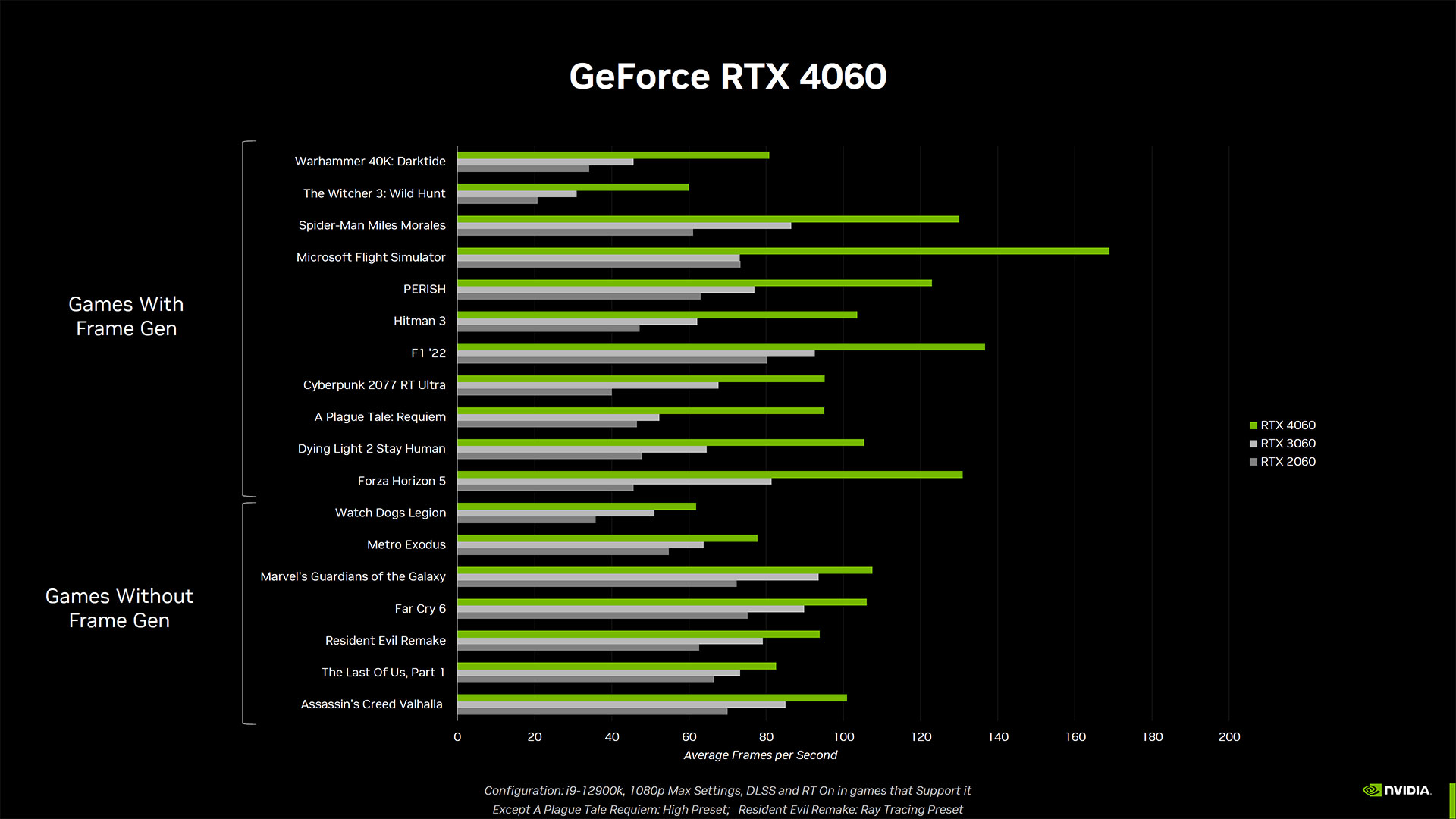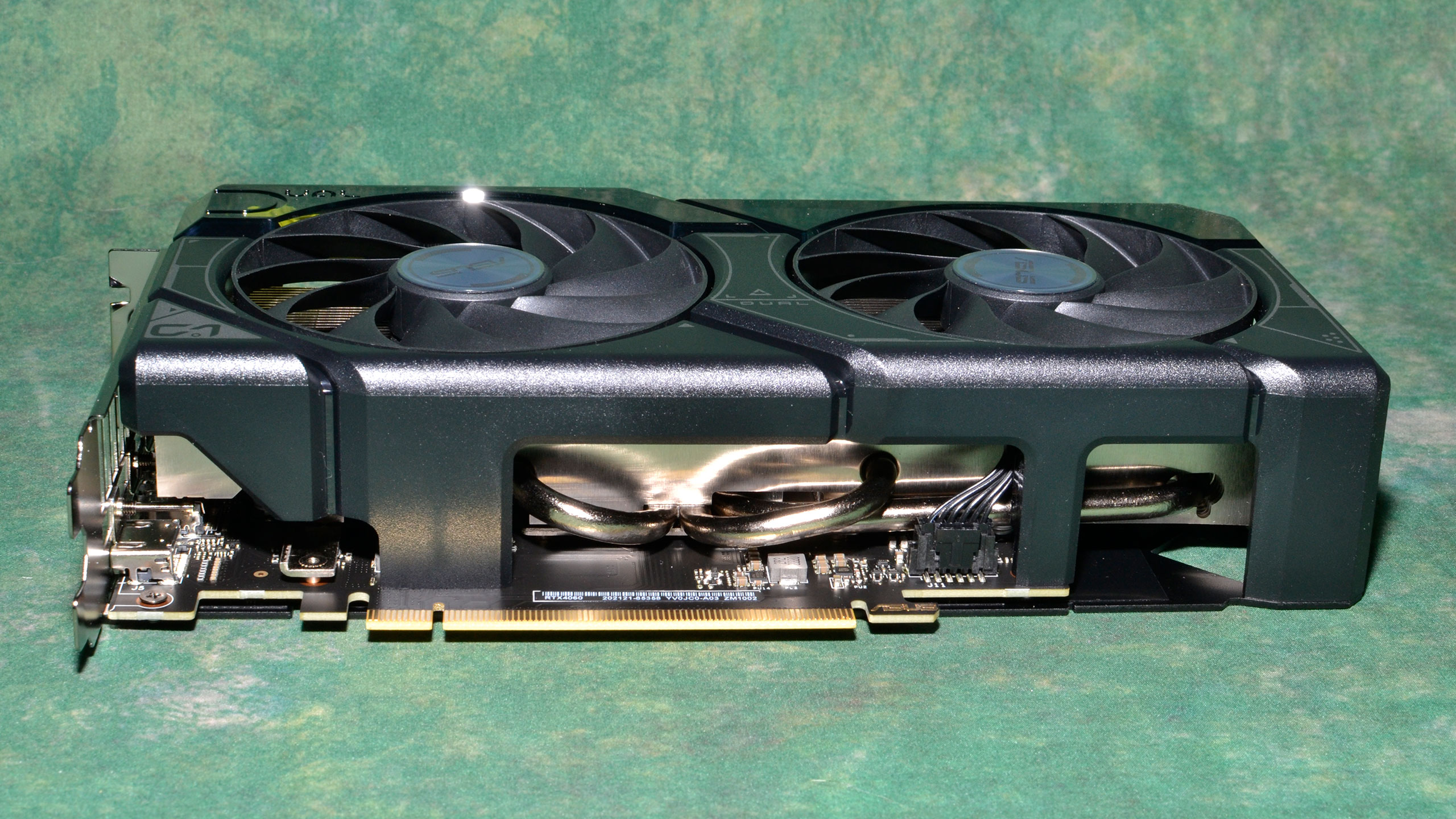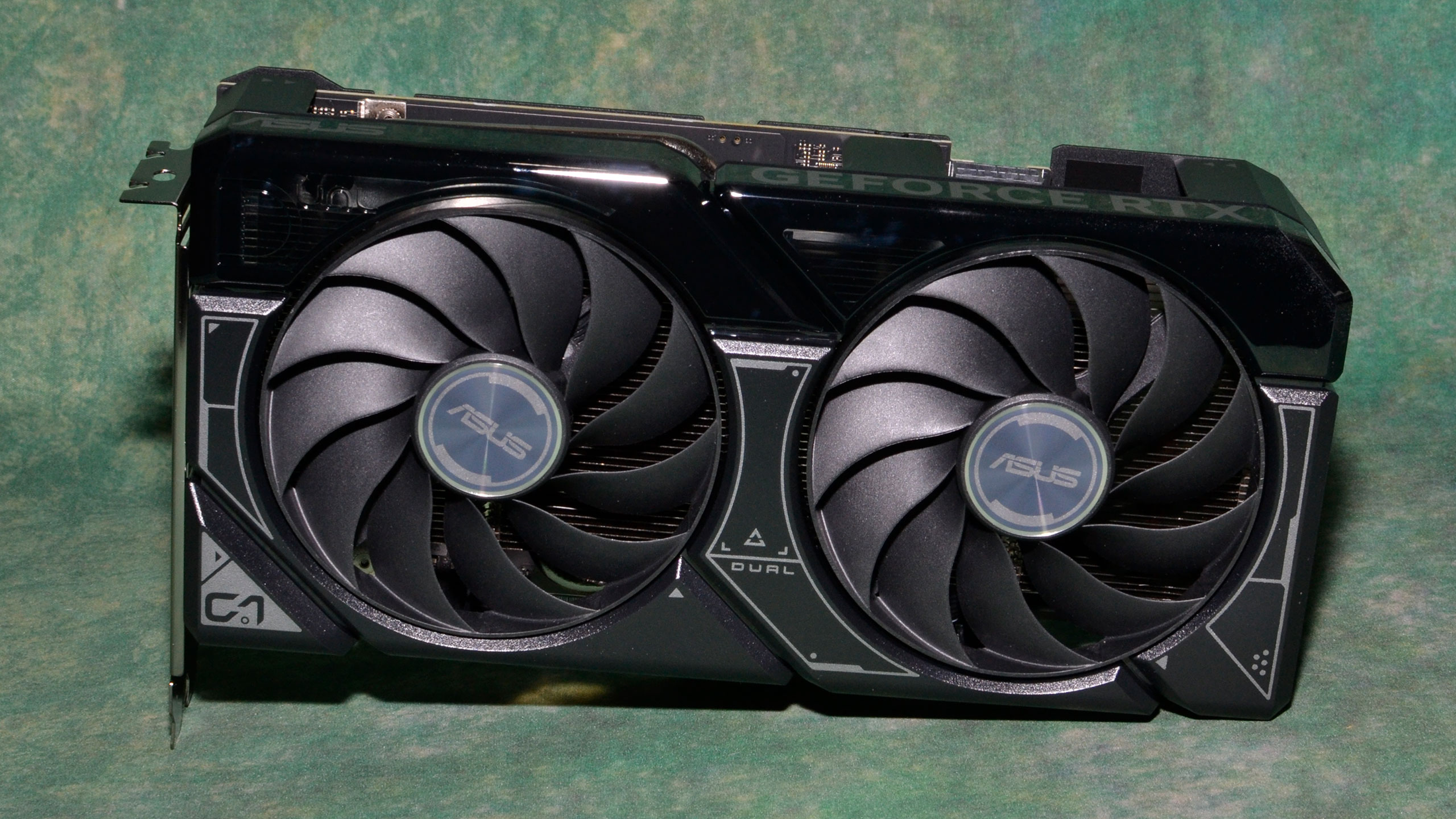Why you can trust Tom's Hardware
The Nvidia RTX 4060 brings Ada Lovelace down to a truly mainstream price point of $299. That's the same as the launch price of the GTX 1060 6GB Founders Edition back in 2016, $50 cheaper than the RTX 2060 Founders Edition, and $30 cheaper than the RTX 3060 launch price. That's great for mainstream gamers, particularly those who might have a graphics card from several generations back that are looking to upgrade. However, the RTX 4060 definitely makes some compromises, chief among them being the 128-bit memory interface and 8GB of VRAM. Let's put that in perspective.
Last generation's RTX 3060 had a 192-bit interface and 12GB of memory. Prior to that, Nvidia used 192-bit interfaces with 6GB or even 3GB of memory for several generations. The RTX 2060 was a 192-bit interface with 6GB (and later 12GB, though those models came late in the cycle and were rarely seen). GTX 1660-series GPUs were also 192-bit with 6GB of memory. The GTX 1060 had a 192-bit interface, with either 3GB or 6GB. In fact, you have to go all the way back to the GTX 960 from 2015 before you can find an xx60-class Nvidia card that used less than a 192-bit interface.
Viewed in that light, Nvidia has rolled back the clock eight years. Yes, the large L2 cache helps mitigate the memory bandwidth associated with the 128-bit interface, but it really, really sucks that we even need to have this conversation. When Nvidia designed the various Ada Lovelace GPUs, it skimped on memory interface width and thus memory capacity on virtually every model, other than the top-tier RTX 4090. After the RTX 3060 moved to 12GB, it's a slap in the face to go back to 8GB on the mainstream model.
Is it the end of the world? No. Many games will still run fine with 8GB. All games that are coded in an intelligent fashion should have an option for texture settings that won't exceed 8GB at 1440p or 1080p, at least for the next several years. But there will invariably be games that push beyond 8GB, and it's definitely a step back from the 3060's 12GB. We thought we were done with 8GB on cards priced above $300 after the previous generation, but Nvidia giveth, and Nvidia taketh away.

Like the RTX 4060 Ti, we'd feel so much better about the RTX 4060 if it had 12GB of memory and a 192-bit memory interface. We also need to look at generational improvements to see how much Nvidia is counting on "neural rendering" and specifically DLSS 3 Frame Generation to try and tell a story about improved performance.
Based on our GPU benchmarks hierarchy testing, the RTX 2060 delivered 75% higher performance than the prior generation GTX 1060 6GB. There was also the GTX 1660 Super that dropped the ray tracing and DLSS aspects of the Turing architecture and got the price down to $229, while still delivering 40% higher performance than the 1060 6GB. Last generation's RTX 3060 meanwhile was about 30% faster than the RTX 2060 — not a huge improvement in performance, but still pretty reasonable, especially since it came with twice as much VRAM.
The new RTX 4060? It's 22% faster than the RTX 3060 on average, at 1080p, but it also comes with 33% less memory. It's one of the smallest generational improvements we've seen from Nvidia for an xx60-class GPU going back to at least the Maxwell era, and probably further than that.


Nvidia will trot out performance charts like the above showing performance with DLSS upscaling and frame generation to make things look better. If you buy into the marketing, with frame generation (aka, neural rendering), the RTX 4060 offers up to a 70% generational improvement over the RTX 3060. That's a seriously skewed view of how Frame Generation works and how it feels, unfortunately.
In practice, we'd credit Frame Generation with maybe a 15% boost to the overall performance you get from the RTX 4060 and other RTX 40-series GPUs. It's not bad in and of itself, but it's also not ideal. You're trading off lower latency and increased responsiveness for smoother framerates. It's definitely something I can feel when playing games.
There are other concerns as well. For one, DLSS 3 support is far more limited than DLSS 2 support right now. It's in something like 38 games at present, compared to over 300 games with DLSS support in general. But another issue is that we've encountered several DLSS 3 titles where the feature basically broke because of a patch.
When we tested Diablo IV, we found that enabling Frame Generation reduced performance on all of the RTX 40-series GPUs. We haven't confirmed whether the latest game updates have fixed the problem, but even so, it wasn't really needed. For this review, Frame Generation also broke in Forza Horizon 5, though Nvidia's own numbers suggest that it would only have improved performance by about 25% — the reviewer's guide for the 4060 listed 136 fps at 1080p, compared to the 116 fps that we measured.
But again, half of those frames are interpolated, so the base fps — the rate at which user input is sampled — would be 78 compared to the DLSS upscaled without Frame Generation result of 108 fps. Does a real 108 fps feel better than an interpolated 136 fps? Yes, we think it does. Does it look better to the eyes? That's a bit more debatable, though Frame Generation does at least allow people to make better use of high refresh rate monitors.

The RTX 4060 isn't a terrible card by any means. Some people will probably say it is, but across our benchmark suite, it was universally faster than the previous generation RTX 3060 at every setting that mattered (meaning, not counting 4K ultra performance, where neither card delivered acceptable performance). There will be edge cases where it falls behind, like Spider-Man: Miles Morales running 1440p ultra, where minimum fps was clearly worse than on the 3060. But overall? Yes, it's faster than the previous generation, and it even cuts the price by $30 — not that the RTX 3060 was available for $329 during most of its shelf life.
There are other benefits, like the power efficiency. The RTX 3060 consumes about 35W more power than the Asus RTX 4060, for example. Better performance while using less power is a good thing. Other architectural benefits include the AV1 encoding support, and features like Shader Execution Reordering, Opacity Micro-Maps, and Displaced Micro-Meshes might prove beneficial in the future — we wouldn't bet heavily on those, however, as they're all exclusive to the RTX 40-series GPUs right now and require the use of API extensions.
The saving grace for the RTX 4060 is undoubtedly its price tag. AMD already has cards that deliver generally similar performance at the same price, but there are a lot of gamers that stick with Nvidia, regardless of what other GPU vendors might have to offer. Now you can get a latest generation RTX 4060 for $299, with better performance and features than the RTX 3060. Just don't expect it to behave like an RTX 4070 that costs twice as much.
A more benevolent Nvidia, flush with the cryptocurrency and AI profits of the past two years, would have made this an RTX 3050 replacement. With the same $249 price, it would have been an awesome generational improvement, as it's 66% faster than the 3050. That's basically what Nvidia did with the RTX 4090, which is up to 60% faster than the RTX 3090 for nearly the same price. But every step down the RTX 40-series has been a tough pill to swallow.
The RTX 4080 is about 50% faster than the 3080, yet it costs 70% more. The 4070 is 30% faster than the 3070 and costs 20% more. The 4060 Ti has the same launch price as the 3060 Ti, but it's only 12% faster. Now we have the RTX 4060 that undercuts the price of the 3060 by 10% while delivering 20% better performance. That's better than most of its siblings, and maybe there's still hope for an RTX 4050... but probably not.
As with the last several graphics card launches, including the Radeon RX 7600, GeForce RTX 4060 Ti, and GeForce RTX 4070, we end up with similar feelings. It's good that the generational pricing didn't go up with the RTX 4060. For anyone running a GPU that's two or more generations old, the RTX 4060 represents a good upgrade option. But we're still disappointed that Nvidia chose to use a 128-bit interface and 8GB of VRAM for this generation's xx60-class models.
- MORE: Best Graphics Cards
- MORE: GPU Benchmarks and Hierarchy
- MORE: All Graphics Content
Get Tom's Hardware's best news and in-depth reviews, straight to your inbox.
Current page: Nvidia RTX 4060: Mainstream Compromises
Prev Page Nvidia RTX 4060: Power, Clocks, Temps, and Noise
Jarred Walton is a senior editor at Tom's Hardware focusing on everything GPU. He has been working as a tech journalist since 2004, writing for AnandTech, Maximum PC, and PC Gamer. From the first S3 Virge '3D decelerators' to today's GPUs, Jarred keeps up with all the latest graphics trends and is the one to ask about game performance.
-
healthy Pro-teen Nvidia's marketing be like: In germany you could maybe save $132 over 4 years if you play 20hours/week due to energy costs compared to the 3060. That is hilarious and obviously the tiny 50 tier die is efficient lol.Reply -
tennis2 @JarredWaltonGPU I feel compelled to give you huge props for the stellar write-up!Reply
Only made it halfway through the article, so I'll have to come back when I have time to finish, but wow....there's so much good stuff here. I hope everyone takes the time to fully read this article. I know that can get tricky once the "architecture launch" article is done for a generation. It's nice to be able to learn some new things from a "standard" GPU review even after I've been reading reviews from multiple sites of every GPU launched for the past.....10+ years. -
lmcnabney The expectations for GPUs going back decades is that the new generation will provide performance in-line with one or sometimes two tiers above it from the prior generation. That means the 4060 should perform somewhere between a 3060ti and 3070. It doesn't. It can't even meet the abilities of the 3060ti. This card should not receive a positive review because it fails at meeting the minimum performance standard.Reply -
oofdragon Utterly crap.. can't even match a 3060Ti, but of course since that amazing accomplishment goes to the failure 4060Ti. Meanwhile anyone can get a 6700XT with 12GB VRAM for half the price. FAIL FAIL FAIL FAIL FAIL FAIL FAILReply -
Elusive Ruse Thanks for the review, however your test suite is outdated. You need to consider bringing a host of newer releases.Reply -
DSzymborski Replyoofdragon said:Utterly crap.. can't even match a 3060Ti, but of course since that amazing accomplishment goes to the failure 4060Ti. Meanwhile anyone can get a 6700XT with 12GB VRAM for half the price. FAIL FAIL FAIL FAIL FAIL FAIL FAIL
You're comparing a used GPU to a new GPU. That increased risk is a fundamental difference which has to be addressed in any comparison. -
Elusive Ruse Reply
You can get a new one around $310-$320DSzymborski said:You're comparing a used GPU to a new GPU. That increased risk is a fundamental difference which has to be addressed in any comparison. -
DSzymborski ReplyElusive Ruse said:You can get a new one around $310-$320
He's literally quoting $200 above as his point of comparison. That's a used card. -
randyh121 Reply
lol the 6700XT is nearly 500$ and the 4060 runs betteroofdragon said:Utterly crap.. can't even match a 3060Ti, but of course since that amazing accomplishment goes to the failure 4060Ti. Meanwhile anyone can get a 6700XT with 12GB VRAM for half the price. FAIL FAIL FAIL FAIL FAIL FAIL FAIL
keep lying to yourself amd-cope

